The Catholic Church was a major force against martial law in the Philippines. This time was filled with human rights abuses and social unrest. With about 75% of Filipinos being Catholic, the Church’s voice mattered a lot in politics.
Leaders like Cardinal Jaime Sin spoke out against the Marcos regime. They were key in the Church’s fight against martial law.
The Church stood up for human dignity and the rights of the poor. Its fight against martial law shows its commitment to justice and human rights. From 1972 to 1986, the Church worked hard to help the poor, with 24 bishops openly opposing martial law.
Key Takeaways
- The Catholic Church played a significant role in opposing martial law in the Philippines.
- Cardinal Jaime Sin was a key leader in the Church’s opposition to martial law.
- The Church’s commitment to human dignity and social justice drove its stance against martial law.
- Approximately 75% of the Philippine population identifies as Catholic, giving the Church significant influence on political matters.
- The martial law period in the Philippines lasted from 1972 to 1986, spanning 14 years.
- The Church’s opposition to martial law was marked by its efforts to address the plight of the poor and marginalized.
Historical Context of Martial Law in the Philippines
The declaration of martial law in the Philippines was a key moment in the country’s history. It started a time of repression and violence under the Marcos regime. To grasp this event, we must look at the political situation before martial law was declared.
The Philippines was facing economic troubles, including a big trade deficit by 1975. Real income for workers dropped by 30 percent during martial law. The government tried to control the economy and silence opposition, making the political climate worse. President Marcos declared martial law on September 21, 1972, to restore order.
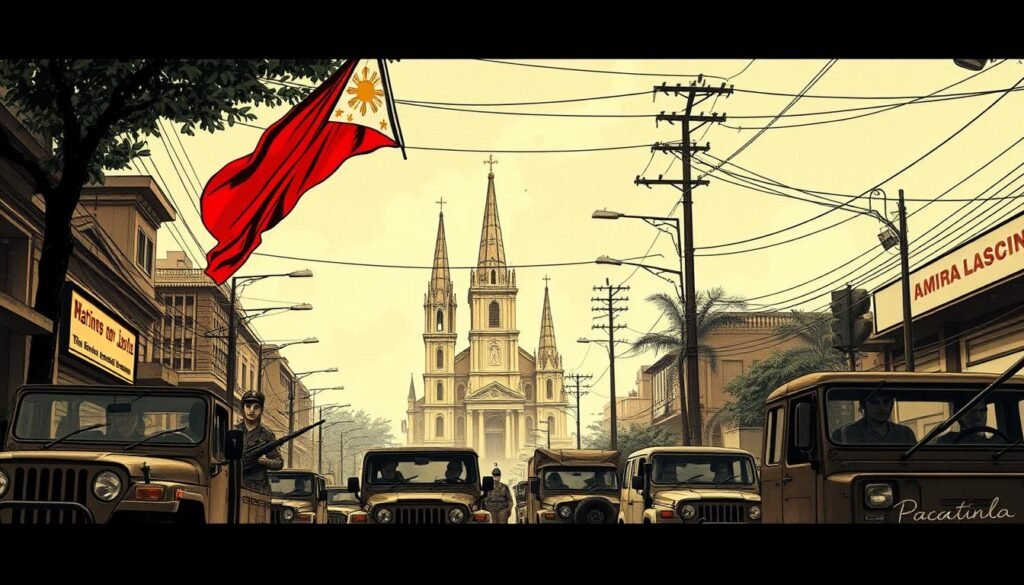
Before martial law, tensions between the government and opposition groups like the New People’s Army (NPA) grew. The NPA was seen as a big threat to the government. The Marcos regime arrested thousands, with many being tortured.
Socio-Economic Factors
The reasons for martial law in the Philippines were complex. Some key factors include:
- Decline in real income of wage labor by 30 percent during the martial law period
- Trade deficit of $1.04 billion by 1975
- Foreign debt rose from P2.7 billion in 1972 to P6.3 billion in 1975
- Income taxes dropped from 28 percent of tax receipts in 1972 to 26 percent in 1975
These issues, along with growing opposition to Marcos, made the political climate very unstable. This led to martial law in the Philippines. Understanding this event’s impact on the country’s history is crucial.
The Catholic Church’s Initial Stance
The Catholic Church was cautious and critical of martial law at first. It worried about how martial law affected human rights and the poor. The Church also criticized the regime for being too controlling.
The Church wanted stability but also believed in talking things out. This was seen in its early actions and words during martial law. The Church’s history of facing persecution, like during the Roman Empire, shaped its views.
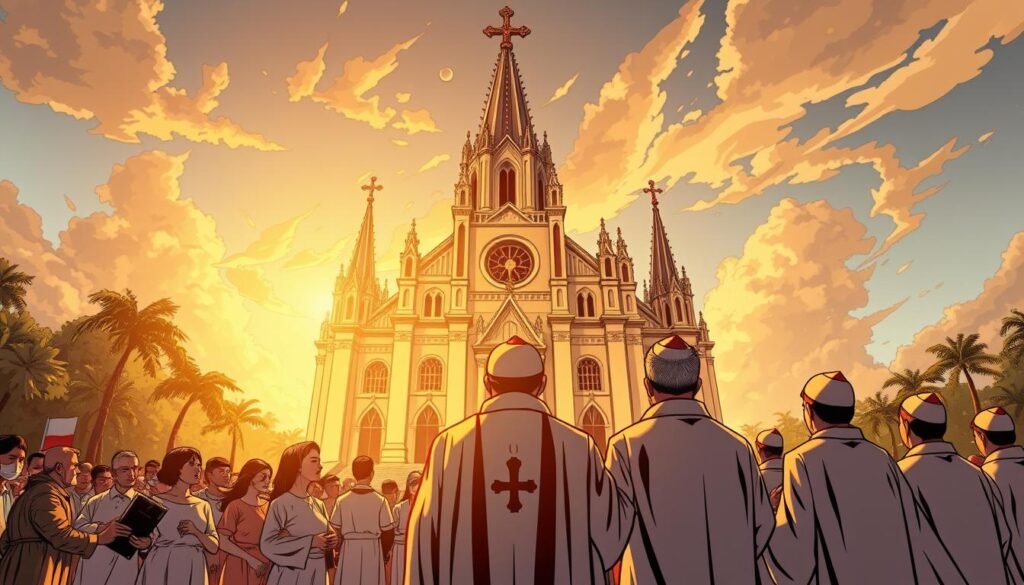
The Church’s worries about martial law came from its teachings on justice and rights. It has always stood up for the common good and those who are weak. The Church’s leaders, like bishops, were key in forming its stance on martial law.
Some important points about the Church’s stance on martial law are:
- Criticism of the regime’s authoritarianism
- Concern for human rights and the poor
- Call for dialogue and reconciliation
- Commitment to promoting justice, peace, and human dignity
The Church’s initial stance on martial law shows its complex views on social and political issues. It wanted stability but also protected human rights and justice. This approach has been part of the Church’s teachings and actions, guiding it through martial law and other challenges.
Evolution of Church Opposition
The Catholic Church’s view on martial law changed a lot over time. It moved from being cautious to openly opposing it. This change came after key events, like the arrest of Church leaders and the death of Church workers. These events made the Church rethink its role in fighting human rights abuses and social injustices.
The Church’s opposition grew stronger. It showed that their stance change was not just a response to martial law. It was a necessary step to help the marginalized and oppressed. The Church realized it had to speak out against human rights abuses and support the poor and marginalized. This marked a big shift in their approach to Church opposition.
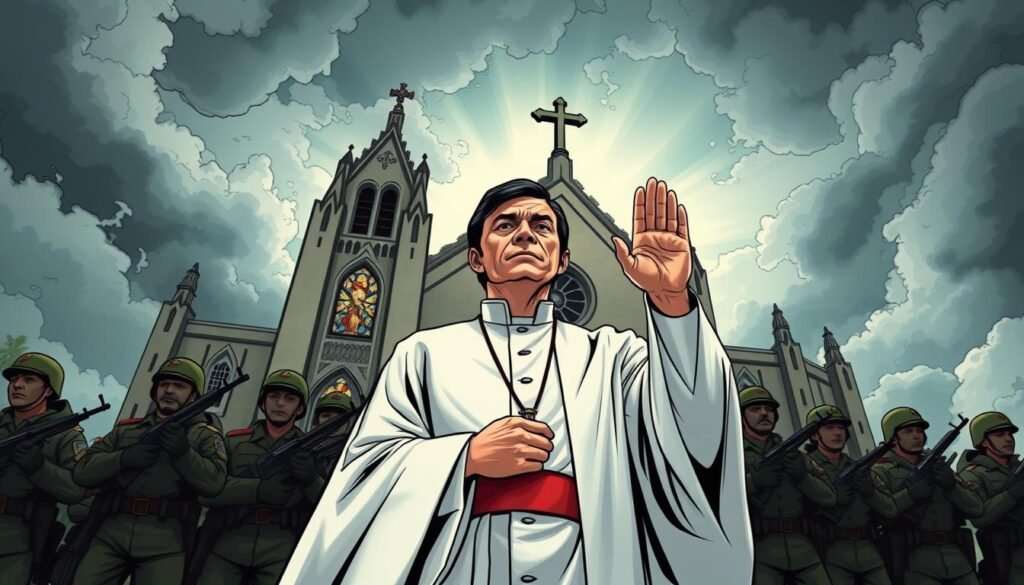
Key Factors Influencing the Church’s Stance
Several factors led to the Church’s change in opposition to martial law:
- Increased human rights abuses and violence under martial law
- The arrest and killing of Church leaders and workers
- The growing awareness of the Church’s role in promoting social justice and protecting the marginalized
The Church’s move from silence to resistance was slow. It was influenced by many factors, like the rise in human rights abuses and the need to protect its followers. As the Church continued to evolve, it became clear that their opposition to martial law was more than just a reaction. It was a deep commitment to justice, peace, and human dignity. This marked a significant milestone in the evolution of Church opposition to martial law.
Key Religious Leaders in the Resistance Movement
The Catholic Church was a big part of the fight against martial law. Leaders like Cardinal Jaime Sin and Bishop Francisco Claver spoke out against the Marcos regime. They pushed for human rights and justice.
These leaders helped organize protests and worked with other groups. They aimed to unite people against oppression. Their goal was to change the Philippines and bring back democracy.
Here are some examples of their impact:
- Cardinal Jaime Sin’s leadership in the Catholic Church helped rally opposition against Marcos.
- Bishop Francisco Claver’s fight for human rights and justice inspired many to join the resistance.
- The Association of Major Religious Superiors of the Philippines (AMRSP) published reports critical of the government.
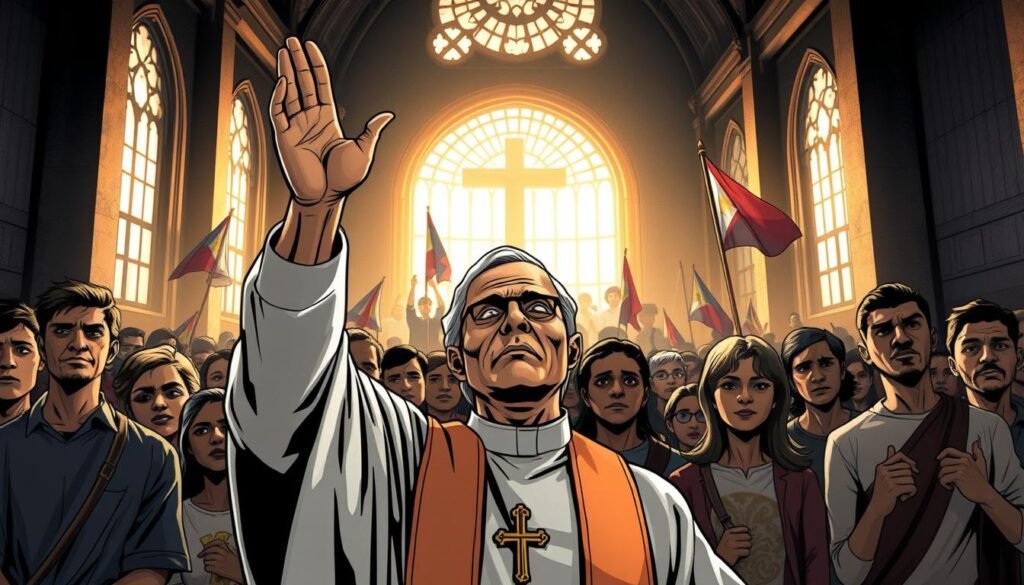
The role of these religious leaders in the resistance against martial law was huge. Their bravery and belief inspired a whole nation. Their legacy reminds us of faith and activism’s power against oppression.
Radio Veritas and Church Media
Radio Veritas was key in the Philippines, especially when censorship was around. It was a Church media outlet that let the Catholic Church share news and facts. It had a strong signal, reaching many people with its 50,000 watts power.
The station covered big events like the People Power Revolution in 1986. This event led to President Ferdinand Marcos being removed. It also reported on Mount Pinatubo’s eruption in 1991 and Pope John Paul II’s visit in 1995.
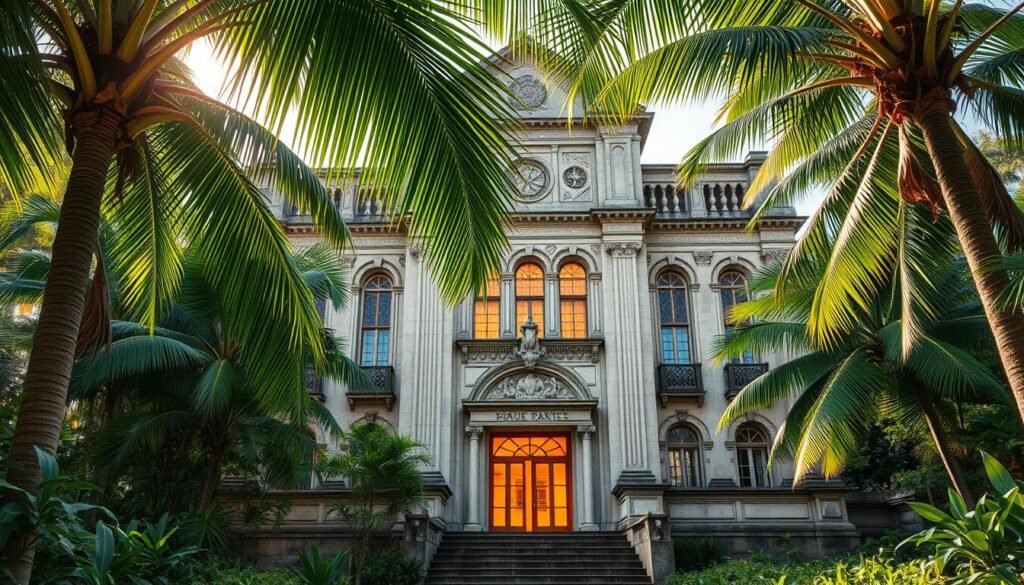
Broadcasting Truth During Censorship
When censorship was strict, Radio Veritas and Church media were vital. They spread truth and facts to the public. The Catholic Church used these outlets to fight against government lies and rally people against the government.
They reported on many important events, like the death of Senator Benigno Aquino Jr. in 1983 and the EDSA Revolution in 2001. Radio Veritas’s dedication to truth has made it a reliable news source in the Philippines. Its fight against censorship and support for Church media is unmatched.
The Catholic Church’s Role in Protecting Activists
The Catholic Church was key in protecting activists during martial law. It gave shelter and support to those facing persecution. This showed its strong support for human rights and justice.
This help was vital for many activists who faced arrest, torture, or death. The Church’s actions saved lives.
The Church did more than just provide shelter. It also fought for the release of detained activists. It spoke out against human rights abuses. This helped bring attention to the activists’ struggles.
For more on human rights in the Philippines, visit this website.
The Church’s actions during martial law show its commitment to human dignity and justice. It stood with the persecuted, showing its support for democracy and human rights. 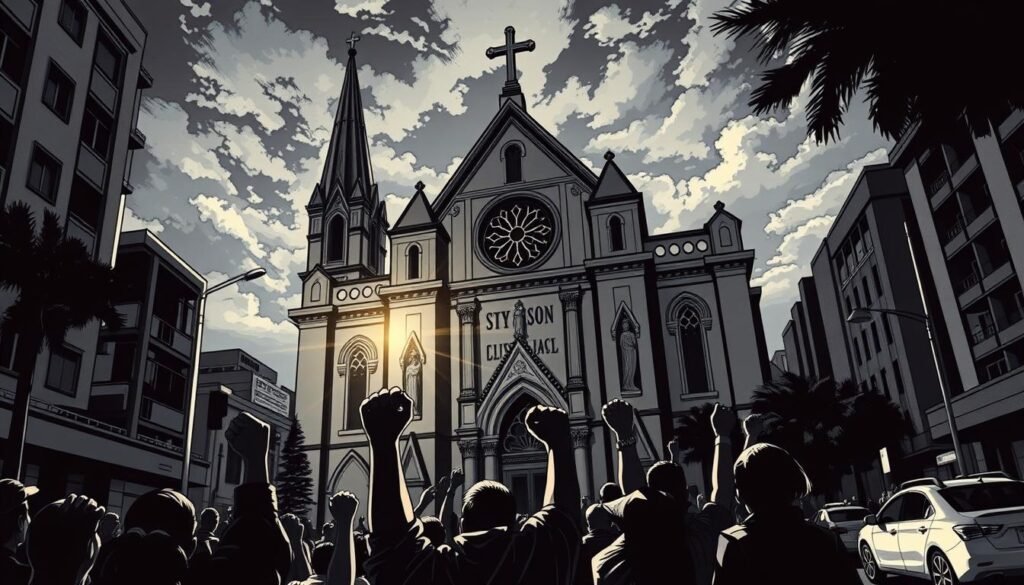
Some key aspects of the Church’s protection of activists include:
- Providing shelter and support to those being persecuted
- Advocating for the release of detained activists
- Speaking out against human rights abuses
These efforts were crucial in safeguarding the lives of many activists. They promoted a culture of human rights and social justice in the Philippines.
Pastoral Letters and Public Statements
The Catholic Church has a long history of addressing social and moral issues. It issues pastoral letters and public statements to guide Church workers and lay leaders. These documents also advocate for human rights and social justice.
In the Philippines, the Catholic Bishops’ Conference of the Philippines (CBCP) has made many statements. They have spoken out on human trafficking, natural disasters, and environmental concerns.
Church documents have tackled issues like martial law, immigration, and healthcare. For example, the CBCP has condemned human rights abuses and pushed for social justice. These actions show the Church’s dedication to fighting injustice and promoting the common good.
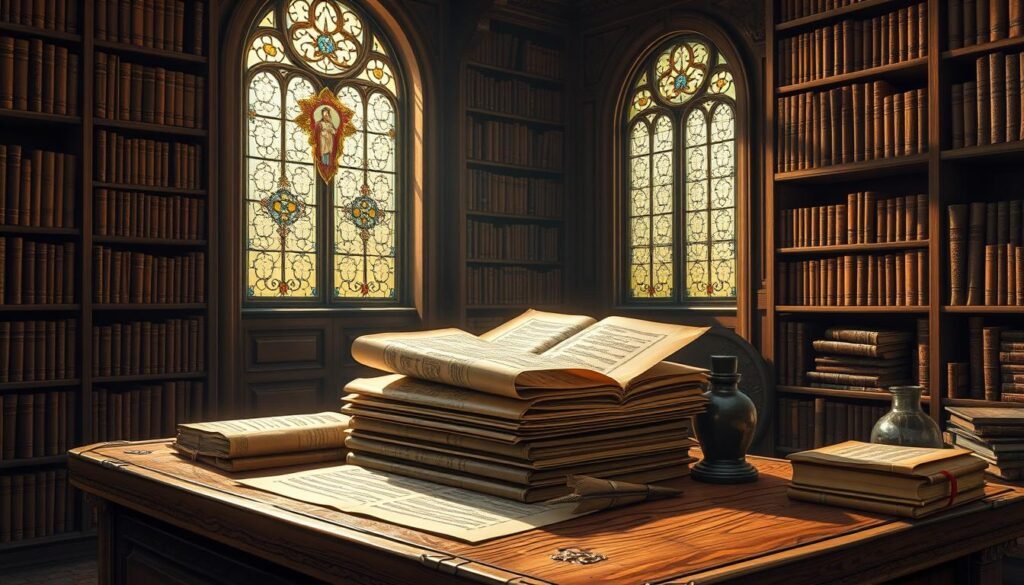
The CBCP has released many public statements, with at least 8 in 2023. These statements have covered topics like climate emergencies, social justice, and human rights. The Church’s use of pastoral letters and public statements has helped raise awareness and encourage action.
Some key statistics on the Church’s public statements include:
- Over 300 documented letters and statements from 2000 to 2024
- Approximately 30% of statements from 2018 to 2023 focused on social justice and human rights
- At least 3 specific statements addressing human trafficking issues between 2018 and 2023
- 5 statements regarding natural calamities and their impacts released from 2018 to 2023
Church-Led Demonstrations and Protests
The Catholic Church was key in organizing Church-led demonstrations against martial law. They saw the need to get the public on their side and push for change. These efforts included prayer vigils and marches led by top religious figures.
The Church’s fight against martial law was clear in the many protests and demonstrations. Leaders like Cardinal Jaime Sin and Bishop Francisco Claver were at the forefront. They used their power to draw attention and gather support.
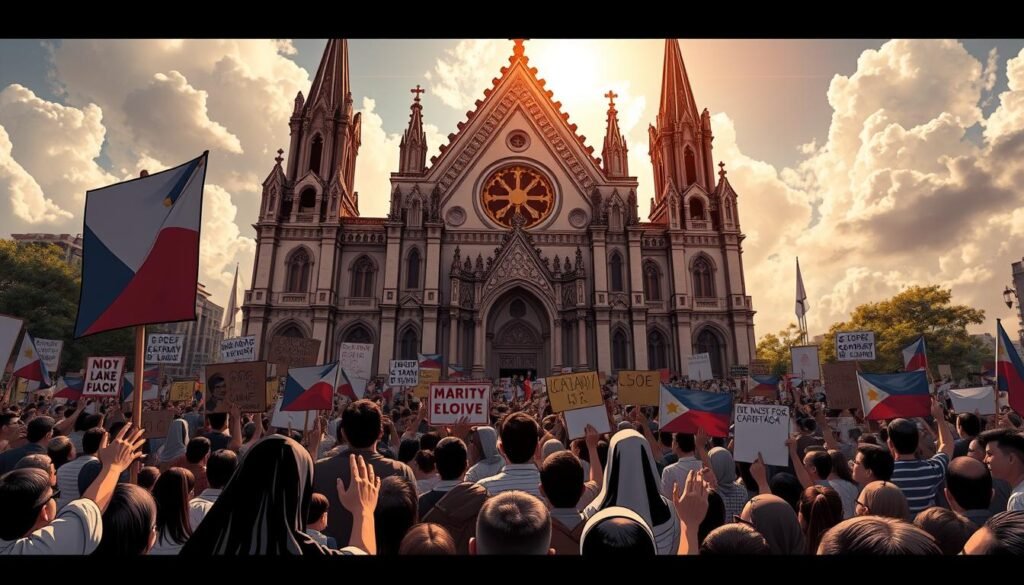
These Church-led demonstrations and protests made a big difference. They helped people understand the problems with martial law and the need for change. The Church’s role also helped build public support for the opposition. This support was crucial in ending martial law and bringing back democracy.
Some key moments of the Church’s involvement include:
- Prayer vigils and protest marches led by Cardinal Jaime Sin and Bishop Francisco Claver
- Public statements and pastoral letters issued by the Church’s leadership, condemning the abuses of martial law and calling for reform
- Support for opposition groups and activists, providing a platform for their voices to be heard and their causes to be promoted
International Catholic Support
The Catholic Church in the Philippines got a lot of international Catholic support during martial law. This support was key in the Church’s fight against martial law and for human rights. The Vatican was critical of martial law and urged the Church to speak out against human rights violations.
The Vatican guided the Church, pushing for dialogue and reconciliation. The Church’s global connections helped gather support and resources for those hit by martial law. The world, including Catholic groups and individuals, denounced the human rights abuses and backed the Church’s quest for justice and peace.
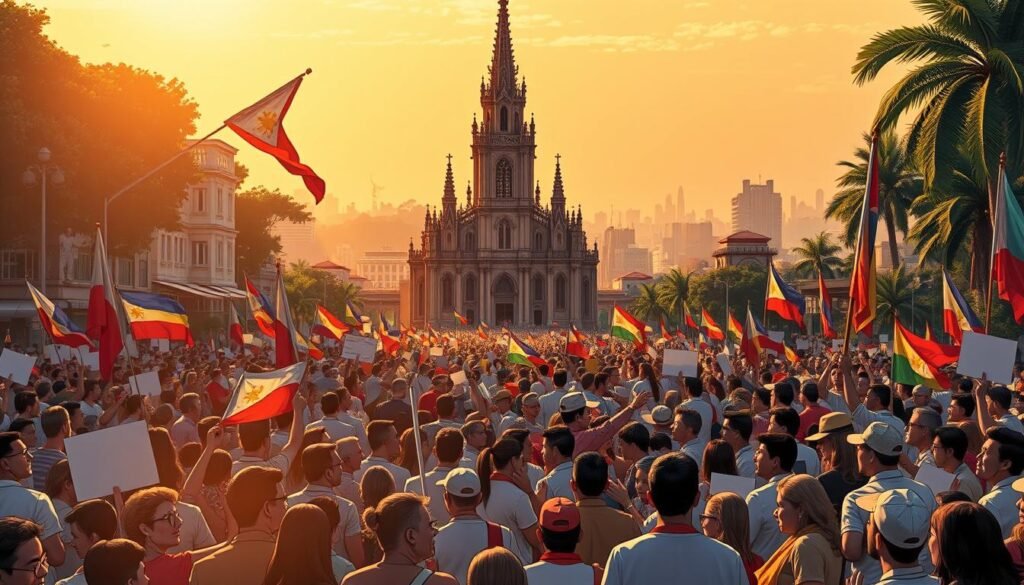
Global Catholic Network
The Catholic Church has a huge global network, almost everywhere. This network helped the Church get international support and resources for martial law victims. The Church’s global ties were crucial for unity and cooperation among Catholics worldwide.
- CCIC has a total of 291 members worldwide
- Membership is open to approximately 6000 entities, including dioceses, universities, and development agencies
- CCIC operates in 37 countries, with members in Africa, Asia, Europe, Middle East, North America, Oceania, and South America
The Vatican’s stance on martial law shaped the Church’s response. The Church’s global support and network allowed it to speak out strongly against human rights abuses. It advocated for justice and peace.
Religious Education as Resistance
Religious education was key in fighting against martial law. The Catholic Church taught people about their rights and social justice. A study showed 82% of people knew about their religious beliefs, showing its impact.
The Church used religious education to rally people and push for change. This was part of the Catholic Nonviolence Initiative. It taught nonviolent resistance for social justice. Under martial law, it empowered people to resist oppression.
Some key statistics show its impact:
- 71% of people said religion was important in their life.
- 57% prayed several times a week.
- High-school graduates in Germany got about 1,000 hours of religious education.
The Church’s religious education helped create a culture of resistance against martial law. It empowered people to fight for their rights and social justice. This was vital in shaping the resistance and ending martial law.
The Church’s Human Rights Documentation
The Catholic Church has been key in human rights documentation. This is especially true during martial law and dictatorship. The Church offers a space for people to share abuses and violations. This helps bring attention to victims and fights for their rights.
In Chile, the Vicariate of Solidarity was set up in 1976. For 16 years, it documented over 47,000 human rights violations. This included judicial files, affidavits, photos, and press articles. This work was vital for the National Truth and Reconciliation Commission.
The Church’s work on human rights documentation comes from its belief in human dignity. By recording abuses and violations, the Church promotes respect for human rights. It also stands up for those who are vulnerable.
Coalition Building with Other Religious Groups
The Catholic Church saw the value in coalition building with other religious groups during martial law. By joining forces, they could push for human rights and social justice better. This wasn’t just the Catholic Church, though. Other religious groups also came together to share their values and goals.
A study found that 73% of advocacy groups have roots in specific religious traditions. Another 26% mix interests from different faiths or focus on religion-related issues without a specific tradition. This mix allows religious groups to tackle many issues, from social justice to human rights, more effectively.
For instance, the historic Catholic-Protestant coalition building in the US has been studied. It shows how it impacts the Christian Right’s efforts to change US politics. In the Philippines, the Catholic Church’s coalition building with other religious groups during martial law helped stir public opinion and push for reforms.
Here are some stats on the diversity of coalition building among religious groups:
- 19% of advocacy groups represent Catholicism
- 18% represent evangelical Protestantism
- 7% represent mainline denominations
- 8% are Muslim
- 12% are Jewish
These numbers show how important coalition building is among religious groups. It helps them promote their causes and fight for human rights and social justice, even under martial law.
People Power Revolution and the Catholic Church
The People Power Revolution was a key moment in Philippine history, ending the Marcos regime. The Catholic Church was crucial, with Cardinal Sin leading the way. The Church aimed to rally public support and push for change.
Key Events and Figures
The revolution started with Benigno Aquino Jr.’s assassination in August 1983. This sparked widespread protests. A coalition formed, leading to big political actions against Marcos.
- Cardinal Jaime Sin called for action, asking Filipinos to protect those fleeing troops.
- The Catholic Bishops’ Conference of the Philippines (CBCP) called the 1986 snap elections a fraud.
- More than 2,000,000 people joined the People Power Revolution from February 22 to 25, 1986.
The Catholic Church’s role in the People Power Revolution was huge. Its leadership was key to the opposition’s victory. The Church’s dedication to justice and human rights remains vital in the Philippines.
| Event | Date | Description |
|---|---|---|
| Assassination of Benigno Aquino Jr. | August 1983 | Triggered widespread civil disobedience among Filipinos |
| People Power Revolution | February 22-25, 1986 | Over 2,000,000 protestors participated in the revolution |
Impact on Church-State Relations
The Catholic Church’s stance against martial law in the Philippines greatly affected Church-state relations. The Church saw the need to speak out against human rights abuses and push for social justice. This change made the Church more outspoken and active in criticizing the regime.
The Second Vatican Council was key in changing the Church’s view on Church-state relations. It emphasized the importance of religious freedom and the separation of church and state.
The Church’s fight against martial law showed the need to protect human rights and fight for social justice. In the Philippines, the Church’s efforts helped strengthen Church-state relations. It became a key player in promoting democracy and human dignity.
The Church’s opposition to martial law still has an impact today. The Church continues to play a vital role in promoting Church-state relations and fighting for human rights and social justice in the Philippines.
FAQ
What was the role of the Catholic Church in opposing martial law in the Philippines?
The Catholic Church was a key player in opposing martial law. It stood up for human rights and social justice. It also supported activists and those hurt by the regime.
What was the political climate like in the Philippines before the declaration of martial law?
Before martial law, the Philippines was in turmoil. People opposed the Marcos regime for its authoritarian ways and human rights abuses.
How did the Catholic Church initially respond to the declaration of martial law?
At first, the Catholic Church was cautious but critical of martial law. It wanted stability but also spoke out against the regime’s wrongdoings.
How did the Catholic Church’s opposition to martial law evolve over time?
Over time, the Church’s opposition grew stronger. It moved from caution to openly resisting martial law. It focused on human rights and helping the poor.
Who were some key religious leaders in the resistance movement against martial law?
Cardinal Jaime Sin and Bishop Francisco Claver were key figures. They fought for human rights and social justice. They guided Church workers and lay leaders.
What role did Radio Veritas and Church media play in the resistance movement?
Radio Veritas and Church media were crucial. They spread truth during censorship. They countered regime propaganda and rallied public opinion.
How did the Catholic Church protect activists during martial law?
The Church gave shelter and support to activists. It advocated for their freedom. It gave a voice to those fighting for justice.
What notable documents did the Catholic Church issue during the martial law period?
The Church issued important documents like pastoral letters. These guided Church workers and advocated for justice and human rights.
Did the Catholic Church lead any demonstrations or protests against martial law?
Yes, the Church led protests against martial law. It aimed to mobilize public opinion and push for change. Key events included a prayer vigil and a protest march.
What was the Vatican’s position on martial law in the Philippines?
The Vatican was critical of martial law. It urged the Church to speak out against abuses. It guided the Church in the Philippines.
How did religious education contribute to the resistance movement against martial law?
Religious education was vital. It taught people about their rights and responsibilities. It helped them understand social justice and human rights.
What efforts did the Catholic Church make to document human rights abuses during martial law?
The Church worked hard to document abuses. It recognized the need to record and report violations. It provided a platform for people to share their stories.
Did the Catholic Church build coalitions with other religious groups during martial law?
Yes, the Church formed alliances with other religious groups. It worked together to fight for human rights and social justice. This helped mobilize public opinion and push for change.
What role did the Catholic Church play in the People Power Revolution?
The Church was key in the People Power Revolution. Cardinal Jaime Sin led the Church and the opposition. The Church played a big role in ending the Marcos regime.
What was the impact of the Catholic Church’s opposition to martial law on Church-state relations in the Philippines?
The Church’s opposition to martial law changed Church-state relations. The Church became more vocal and active. It spoke out against abuses and advocated for justice.
Source Links
- Martial Law and the Catholic Church in the 1970s
- The Church and martial law
- Church Group Is the Only Opposition in Philippines (Published 1977)
- The Methods of Regime Survival
- Philippine bishops urge people not to forget ‘dark years’ of dictatorship – Vatican News
- History of the Catholic Church
- Roman Catholicism | Definition, Religion, Beliefs, History, & Facts | Britannica
- BBC – Religions – Christianity: Roman Catholic Church
- Catholic Church
- Catholic Church in the United States
- Religious sector resistance against the Marcos dictatorship
- Religious Groups as Movement Allies: Where Strategic Nonviolent Action and Moral Nonviolence Meet | ICNC
- DZRV-AM
- Radio Veritas Global Broadcasting System, Inc.
- Veritas PH – The WORD. The TRUTH. – VeritasPH
- Catholic Church and politics
- The Catholic Church, Human Rights, and Democracy: Convergence and Conflict with the Modern State
- The Catholic Church’s view on human rights
- Pastoral Letters & Statements | LA Catholics
- List of Pastoral Statements
- Poland’s churches become sites of protest
- Chile is reeling from protests. Where is the Catholic Church?
- Church-led talks bring end to deadly protests in Ecuador
- International Catholic Centre for Cooperation with UNESCO
- Religious education in school affects students’ lives in the long run
- The Catholic Resistance to Corporatized College
- The Catholic Church defended human rights during Chile’s dictatorship. An archive tells the story
- Library : Dignitatis Humanae and the Catholic Human Rights ‘Revolutuion’
- The Catholic Church defended human rights during Chile’s dictatorship. An archive tells the story
- Academy for Cultural Diplomacy
- Major Characteristics of Religious Advocacy Groups
- The Catholic Church’s place was at EDSA in 1986, where should it be now?
- People Power Revolution
- Roman Catholicism – Church-State Relations | Britannica
- Relations between the Catholic Church and the state

